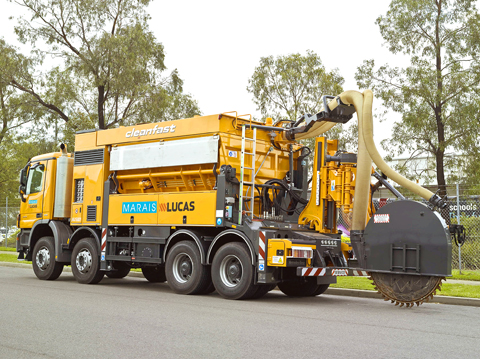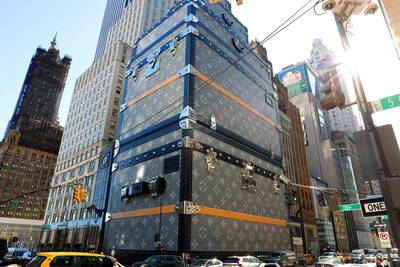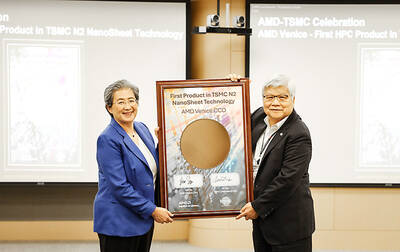From snowy mountains and sun-baked deserts to the steamy tropical north, Australia has begun wiring its vast expanse with a high-tech broadband network in a giant project being closely followed abroad.
Workmen are already digging trenches in Tasmania, the first step in a US$37 billion scheme that Australian Prime Minister Kevin Rudd calls the country’s biggest ever infrastructure venture.
The ambitious plan aims to connect 90 percent of homes, including remote Outback settlements and sprawling coastal cities, with fiber-optic cable by 2017, accelerating lagging network speeds and boosting the economy.

PHOTO: AFP
The sheer scale of the project has drawn interest from foreign governments including the US, where President Barack Obama has outlined similar plans.
Engineers will lay cable across 7.7 million square kilometers of often challenging terrain that covers an area twice the size of the EU.
“There’s no kidding about it, it’s a massive job,” telecommunications analyst Paul Budde said. “You have to physically go to 10 million premises and bring a cable there, either [by] digging it or via [power] poles and then obviously it’s not just having the cable, you have to have the installation in the house.”
Specialized French digging machines have been shipped to Tasmania to lay the first of millions of kilometers of fiber-optic cable. By next June, three pilot towns are expected to be enjoying connection speeds of 100 megabits per second.
Just 0.1 percent of Australians are linked to fiber-optic cable, with most accessing the Internet over the 100-year-old copper telephone network, prompting Rudd to call the country a “broadband backwater.”
Rudd, announcing the project in April, said Australia had some of the developed world’s slowest Internet speeds and lowest access rates.
Some Outback communities rely on dial-up connections and others have no Internet at all.
Industry expert Reg Coutts, who advised the government on the network, said the venture had attracted top-level attention in the US and other countries.
“There’s really an absolute interest, particularly in America, but also in Europe,” he said.
“People are asking: ‘What the hell are you doing and how are you doing it?’ People of course are skeptical,” he said.
Laying the network was only the first step, he said, with the real challenge transitioning 10 million customers from old TV, telephone and Internet networks.
“That alone, we have never seen on that magnitude anywhere in the world,” Budde said.
Once laid, there was “really no limit” to what the fiber network could do, said Ravi Bhatia, CEO of Primus Telecom and spokesman for industry consortium Terria.
He said technological advances in areas such as satellite mapping would make the roll-out easier than it would have been even three years ago, allowing for “smart” deployment of resources and machines to dig and pull cable.
“By using the latest technology building this network we create another set of skills which we can then export to other countries and build their networks,” Bhatia said.
Coutts said there was “a lot of infrastructure that could potentially be utilized in the NBN [National Broadband Network],” but estimated that it was only about 10 percent of what was needed.
“Most of what’s going to go on is purely civil works, actually pulling in and splicing optical fiber to replace the copper,” he said.

TAKING STOCK: A Taiwanese cookware firm in Vietnam urged customers to assess inventory or place orders early so shipments can reach the US while tariffs are paused Taiwanese businesses in Vietnam are exploring alternatives after the White House imposed a 46 percent import duty on Vietnamese goods, following US President Donald Trump’s announcement of “reciprocal” tariffs on the US’ trading partners. Lo Shih-liang (羅世良), chairman of Brico Industry Co (裕茂工業), a Taiwanese company that manufactures cast iron cookware and stove components in Vietnam, said that more than 40 percent of his business was tied to the US market, describing the constant US policy shifts as an emotional roller coaster. “I work during the day and stay up all night watching the news. I’ve been following US news until 3am

Six years ago, LVMH’s billionaire CEO Bernard Arnault and US President Donald Trump cut the blue ribbon on a factory in rural Texas that would make designer handbags for Louis Vuitton, one of the world’s best-known luxury brands. However, since the high-profile opening, the factory has faced a host of problems limiting production, 11 former Louis Vuitton employees said. The site has consistently ranked among the worst-performing for Louis Vuitton globally, “significantly” underperforming other facilities, said three former Louis Vuitton workers and a senior industry source, who cited internal rankings shared with staff. The plant’s problems — which have not

TARIFF CONCERNS: The chipmaker cited global uncertainty from US tariffs and a weakening economic outlook, but said its Singapore expansion remains on track Vanguard International Semiconductor Corp (世界先進), a foundry service provider specializing in producing power management and display driver chips, yesterday withdrew its full-year revenue projection of moderate growth for this year, as escalating US tariff tensions raised uncertainty and concern about a potential economic recession. The Hsinchu-based chipmaker in February said revenues this year would grow mildly from last year based on improving supply chain inventory levels and market demand. At the time, it also anticipated gradual quarter revenue growth. However, the US’ sweeping tariff policy has upended the industry’s supply chains and weakened economic prospects for the world economy, it said. “Now

COLLABORATION: Given Taiwan’s key position in global supply chains, the US firm is discussing strategies with local partners and clients to deal with global uncertainties Advanced Micro Devices Inc (AMD) yesterday said it is meeting with local ecosystem partners, including Taiwan Semiconductor Manufacturing Co (TSMC, 台積電), to discuss strategies, including long-term manufacturing, to navigate uncertainties such as US tariffs, as Taiwan occupies an important position in global supply chains. AMD chief executive officer Lisa Su (蘇姿丰) told reporters that Taiwan is an important part of the chip designer’s ecosystem and she is discussing with partners and customers in Taiwan to forge strong collaborations on different areas during this critical period. AMD has just become the first artificial-intelligence (AI) server chip customer of TSMC to utilize its advanced